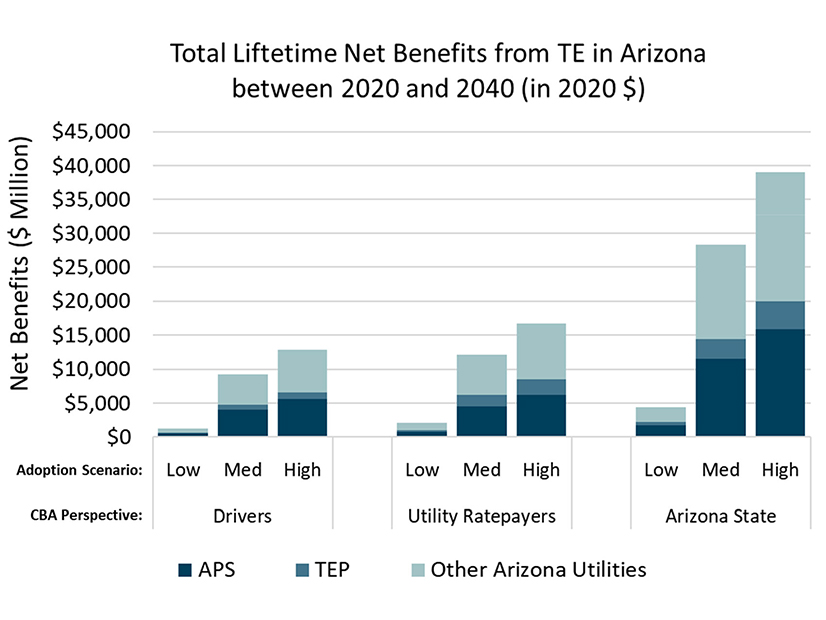The Arizona Corporation Commission has approved a statewide transportation electrification plan developed by utilities and intended to accelerate electric vehicle adoption.
The commission voted 3-1 Wednesday to approve the plan. Commissioner Justin Olson voted “no” and Commissioner Jim O’Connor abstained.
The commission also voted 4-1 in favor of directing investor-owned utilities Tucson Electric Power Co. (TEP), Arizona Public Service Co. (APS) and UNS Electric Inc. to file transportation electrification implementation plans at least every three years, starting next year. Olson was opposed.
In addition, TEP and APS must file semi-annual reports detailing their progress in implementing the transportation electrification plan.
The commission was split on a proposal from Commissioner Sandra Kennedy that would have directed the three utilities to base their EV programs and investments on a “high adoption scenario” analyzed in the transportation electrification (TE) plan.
The high-adoption scenario envisions 1.5 million light-duty electric vehicles on the road in Arizona in 2030, or about 20% of all light-duty vehicles.
That compares to a medium-adoption scenario, with 1 million light-duty EVs in the state by that year, and a low-adoption scenario, with about 250,000 EVs.
Kennedy’s proposal said that the high-adoption scenario would bring a projected $11 billion more in net benefits to the state compared to the medium-adoption scenario. But the proposal failed 2-2, with Olson and commission Chairwoman Lea Marquez Peterson opposed. O’Connor abstained.
According to the TE plan, TEP and APS support establishing an EV goal for their respective service territories based on the statewide medium-adoption scenario. For TEP, the goal is 95,000 EVs on the road by 2030. For APS, the goal is 450,000 EVs.
Aiming High
Several groups had urged the commission to aim for the high-adoption target. Doing so would allow utilities to better plan for peak loads and help certain regions of the state bring their air quality into compliance with federal ozone standards, they said.
But Marquez Peterson raised questions about the high-adoption scenario in a Dec. 13 letter to her fellow commissioners.
Marquez Peterson said the commission must base its decisions on facts and data. She said she found no evidence that the high-adoption scenario would prevent a reclassification of the Phoenix-Mesa area from “marginal” to “serious” ozone nonattainment, which is expected to occur in 2024.
The Arizona Department of Environmental Quality (ADEQ) told Marquez Peterson that the state would need to replace more than 1.3 million internal-combustion-engine vehicles with EVs within the next two years to avoid the reclassification. That assumes EV adoption is the only measure the state pursued to improve air quality.
In addition, the Maricopa Association of Governments (MAG) said that the large drops in traffic related to the COVID-19 pandemic “have not resulted in a comparable reduction in ozone air pollution,” Marquez Peterson said in her letter.
“Until MAG, ADEQ and other stakeholders determine the appropriate number of EVs necessary, there is no adoption scenario modeled in the Phase ll report [transportation electrification plan] that bears any relation to preventing or reversing ozone nonattainment in Arizona,” she wrote.
Marquez Peterson also said the commission does not have authority to require a specific number of EVs or adopt air quality mandates.
Overcoming Barriers
The transportation electrification plan is the result of a 2019 commission decision that ordered the state’s utilities to develop a long-term, comprehensive TE plan.
APS and TEP worked with consultants Energy and Environmental Economics (E3) and Illume Advising to develop the plan, which was released in March. A public workshop on transportation electrification followed in August. (See EV Growth Prompts Need for Managed Charging.)
The plan outlines barriers to transportation electrification and steps that TEP and APS are taking to overcome those obstacles. For example, to address a shortage of EV charging infrastructure, the utilities offer programs such as APS’ Take Charge AZ, which covers costs for installing EV chargers at businesses and multi-family housing.
The plan lists a wide range of recommendations from a stakeholder panel. The stakeholders advised electric utilities to devise EV rates and electrify their own fleets. The state is encouraged to enact zero-emission vehicle legislation and offer incentive programs for EVs and charging infrastructure.
As part of the plan, APS and TEP plan to track progress of transportation electrification through metrics that may include the number of public EV charging stations and plug counts, the number of customers enrolled in EV or time-of-use rates, or a summary of EV programs in each service territory.
Environmental groups were enthusiastic about approval of the transportation electrification plan.
“With more electric cars on our roads, we can lower utility rates, improve air quality, and boost public health outcomes,” Ellen Zuckerman, utility program co-director for the Southwest Energy Efficiency Project (SWEEP), said in a release. “This decision sends a strong signal that Arizona is serious about transportation electrification and all of its great benefits.”



